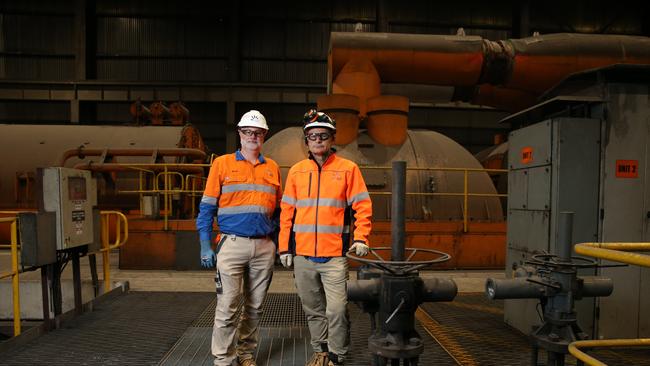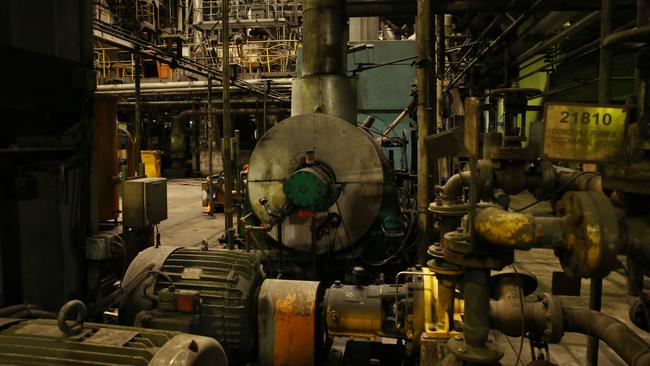AGL: Aussies willing to pay extra for homemade solar
The Liddell coal-fired power station is silent after more than 50 years and AGL Energy plans to transform the 10,000ha site into a renewable energy hub, keeping jobs in the region.

AGL Energy executive Markus Brokhof says undercutting China on solar panel prices is unlikely but users will back a push by the Albanese government to manufacture a superior, locally made product – even if it comes at a higher cost.
The Prime Minister is betting big on the manufacturing moonshot: handing $1bn in subsidies to get the industry ramped up so the nation can break Beijing’s grip on the market.
AGL has signed a preliminary deal with would-be developer SunDrive to potentially establish a solar manufacturing facility at Liddell.
“There are good examples abroad. I spent my life before I came to Australia in Switzerland, and there is a solar manufacturer there. If you look at the economics of Switzerland, there are very high salaries,” Mr Brokhof said.
“People are willing to pay a premium for higher technology made in Australia, but if you add up the technological advantage and the savings on things such as freight there is a good business case.”
China has a stranglehold on solar panel production. But at the site of a shuttered coal-fired plant in NSW’s Hunter Valley, Mr Brokhof – chief operating officer of AGL Energy – believed Australia could get a slice of the market.
A vast green hub is being developed which the power giant hoped would successfully minimise the impact of a transition on the communities once reliant on the fossil fuel.
China controls about 80 per cent of the market, a position it secured by government policy and low labour costs – which Australia could never match.

As a result, critics insist the $1bn funding is economically unjustifiable, and solar manufacturers could be reliant on subsidies for the longer term.
Mr Brokhof, however, said the support should be seen through the lens of a regeneration of areas which would otherwise be hurt by an energy transition.
“We have always said it will take a few parties to dance. You need a partnership approach if you are going to develop this because at the end of the day, Liddell is one small part of a Hunter Region that needs to be transformed,” he said.
“You will need fiscal policies to attract new industries or research and development to make this happen.”
The establishment of solar manufacturing at AGL’s Liddell coal-fired power station is a far cry from its origins, but AGL said it could be the catalyst to transform the site into a future green superpower complete with pumped hydro and batteries.

Opened in 1971, the Liddell Power Station in the Hunter Valley in NSW was once a vital clog in Australia’s power generation. Today, the four turbines sit idle and coal dust lining the walls is one of the reminders of its once eminent position as not only an energy source but an employer of multiple generations in the local community.
Liddell is now just months away from demolition and will be replaced by a large battery that embodies Australia’s transition away from fossil fuels. AGL Energy wants to regenerate the area for new industries which create hundreds of new jobs.
The capacity of AGL to deliver its plan could be a bellwether of Australia’s energy transition.
Liddell is the first coal-fired power station to be closed but nearly all of Australia’s traditional power generators are expected to be shut down within the next 15 years.
That’s being driven by economic and social pressure to reduce emissions in a move that calls time on power stations which are close to the end of their technical lifespan.

To compensate, Australia must rapidly develop huge amounts of wind and solar generation capacity, backed up by gas, large-scale batteries and pumped hydro, the Australian Energy Market Operator has said.
The transition is well behind pace and the shuttering of once dominant economic industries will uproot major communities like the Hunter Valley, which relied on fossil fuel power generation, where as many as 14 per cent of the local population had jobs in coal industries as recently as 2021.
The solution, Mr Brokhof said, was AGL’s so-called energy hubs strategy whereby the almost 200-year-old company would build renewable energy generation capacity that could be exported to the national electricity grid and support new industries which want access to abundant energy sources.
“We believe this should be a blueprint for Australia,” Mr Brokhof said.
In close proximity to Liddell, AGL’s Bayswater coal power station and Origin Energy’s Eraring are both due to be retired soon.
Eraring’s closure is shrouded in mystery as the NSW government wants to negotiate an extension to the lifespan beyond its current scheduled 2025 retirement. Bayswater is scheduled to close between 2030 and 2033.
Each of these coal-powered sites have an abundance of space and, perhaps most importantly, a network of high-voltage transmission lines.

By creating a hub of renewable energy at these sites, Australia could avoid having to build as much infrastructure. Some communities vehemently oppose new transmission lines, which they say will destroy their property values and uproot their businesses, and have vowed to oppose them despite ever larger financial sweeteners offered by state governments.
Mr Brokhof said he hoped for an investment decision from SunDrive next year. But other options are also open to AGL, the company’s general manager of energy hubs, Travis Hughes, said.
“We have identified industries that we think are most viable and most likely. Manufacturing of renewables certainly has a lot of momentum behind it from a government policy perspective, and we are alert to those themes,” Mr Hughes said.
“But we are looking at things that will create jobs, things that are high energy intensive industries, which makes the site more attractive, such as data centres.
“These need a lot of cooling, a lot of space, incredible grid connection with the scale they are getting to now; this is the kind of location that really suits them.”

The energy demands from data centres is surging globally and new regulations in some countries require them soon to be entirely powered from renewable sources.
AGL could soon have an abundant supply of renewable energy in the region. At the Liddell site it will begin construction of a 500MW battery, which would be able to provide electricity for about two hours.
The total construction cost is about $750m and will be funded from the company’s balance sheet.
Nearby it is considering a 400MW pumped hydro project that could provide eight hours of power. A final investment decision is expected around 2026, but if it proceeds it would provide between two and four times the storage duration of a typical battery and last about 100 years, which is well beyond the typical 20-year lifespan of a battery.
Pumped hydro is often described as the missing link of Australia’s energy transition. During periods when abundant electricity is on offer, wholesale electricity prices fall to zero and operators such as AGL could use this to power its pumps to move water uphill.
When wholesale electricity prices climb, typically during the evening peak when the sun has set, AGL could release the water downhill driving generators that produce electricity and earn it significant returns.
AGL Energy contributed to the reporter’s travel costs






To join the conversation, please log in. Don't have an account? Register
Join the conversation, you are commenting as Logout